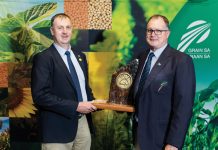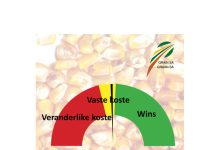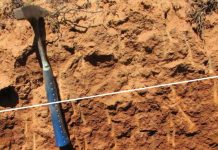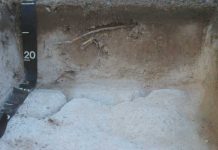



Scientific name: Urochloa panicoides
Afrikaans name: Beesgras
English name: Herringbone grass, Garden urochloa
Description
An annual tufted grass that can grow up to 90 cm high in favourable conditions. Culms are often decumbent with roots at the lower nodes, spreads outwards from the centre. Leaf sheaths are loosened from the culm, finely striped, hairy (hirtous) with small knobs at the base of the hairs, the ligule is a deep, ciliate edge. Leaves are light green and characteristically wavy (undulate), even as a seedling. Inflorescence consists of 2 to 7 spikes, each up to 6 cm long. Spikelets are in two regular rows, alternately arranged on the anthoclinium, hairless (glabrous), with the lower glumes one third of the length of the spikelet. Seeds (caryopses) are straw-coloured, ovally flattened, with fine ridges across one side, with a short, blunt apex.
Urochloa mosambicensis (Bushveld herringbone grass) also occurs commonly and the difference between species can be seen in the florescence.
Distribution:
Herringbone grass can be seen as one of the four “land grasses” due to their wide distribution and common occurrence in most crop species. It seems to prefer clayey soils, but can be a severe competitor on any soil type if the infestation levels is high enough. The grass is distributed through seed and germinate pre-dominantly in early spring.
Control
Cultivation
Timely shallow cultivation can be done in early spring, since seed are shallow germinators and can be one of the first grasses to germinate.
Chemically
Most pre- and post-emergence grass herbicides can be used to successfully control herringbone grass. When the grass is controlled post-emergence, the applications must be applied as early as possible between the two- to four leaf stages. As soon as the herringbone grass starts to form tufts, control can be less effective.
TABLE 1: Herbicides registered for the control of herringbone grass in maize
| Active ingredient | Formula | Time of application |
|---|---|---|
| acetochlor | 700 gram/litre 750 gram/litre 840 gram/litre 900 gram/litre 960 gram/litre | Pre-emergence or early post-emergence of the crop |
| acetochlor/atrazine/simazine | 160/165/165 gram/litre | Pre-emergence or early post-emergence of the crop |
| acetochlor/atrazine/terbuthylazine | 125/187,5/87,5 gram/litre 150/225/225 gram/litre 178,6/160,7/160,7 gram/litre 250/225/225 gram/litre 350/175/175 gram/litre | Pre-emergence, with plant, or within days after planting Early post-emergence, not later than four leaf stage of the weed |
| acetochlor/EPTC | 150/350 gram/litre | Pre-emergence of crop and weed |
| alachlor | 384 gram/litre 480 gram/litre | Pre-emergence, with or just after planting |
| alachlor/atrazine | 336/144 gram/litre | Pre-emergence, with or just after planting |
| atrazine/cyanazine | 167/333 gram/litre 250/250 gram/litre | Pre-emergence or early post-emergence |
| atrazine/mesotrione/s-metolachlor | 208,5/26,8/208,5 gram/litre | Pre-emergence of weed and crop |
| atrazine/metolachlor | 300/300 gram/litre | Pre-emergence, within three days after planting |
| atrazine/s-metolachlor | 370/290 gram/litre | Pre-emergence, within three days after planting |
| atrazine/sulcotrione | 300/125 gram/litre | Pre- or post-emergence application |
| atrazine/terbutryn | 250/250 gram/litre | Pre-emergence, with plant or just after planting |
| dicamba/topramezone | 160/50 gram/litre | Early post-emergence, before six leaf stage, use in tank mixture with atrazine or atrazine/terbuthylazine |
| EPTC | 720 gram/litre | Pre-plant, incorporated into soil, consult product label |
| flumetsulam | 200 gram/litre 800 gram/kg | Pre-emergence, use in tank mixture with metolachlor or s-metolachlor |
| flumetsulam/s-metolachlor | 20/630 gram/litre | With plant, or within three days after planting |
| glyphosate/mesotrione/s-metolachlor | 250/25/250 gram/litre | Post-emergence, only on glyphosate tolerant cultivars |
| mesotrione | 480 gram/litre | Pre- or post-emergence. Use only in tank mixtures with atrazine, atrazine/terbuthylazine, s-metolachlor |
| mesotrione/s-metolachlor | 83,3/416,7 gram/litre | Pre-emergence of weed and crop |
| metolachlor | 800 gram/litre 840 gram/litre 915 gram/litre 950 gram/litre | Pre-emergence, within three days after planting |
| metribuzin | 480 gram/litre | Post-emergence when weeds are actively growing, four to six leaf stage |
| nicosulfuron | 240 gram/litre 40 gram/litre | Post-emergence, when crop is in two to six leaf stage |
| s-metolachlor | 915 gram/litre 960 gram/litre | Pre-emergence, within three days after planting |
| s-metolachlor/terbuthylazine | 312,5/187,5 gram/litre | Early post-emergence, in tank mixture with mesotrione |
| topramezone | 336 gram/litre | Early post-emergence, before six leaf stage, use in tank mixture with atrazine or atrazine/terbuthylazine |
TABLE 2: Herbicides registered for use on wheat for the control of herringbone grass.
| Active ingredient | Formula | Time of application |
|---|---|---|
| trifluralin* | 480 gram/litre | Use only in planted fields, dosage depends on weed species |
* Please note: Always check on the herbicide label that the specific herbicide is registered for use on the named weed species. Only certain tradenames are registered for the control of herringbone grass.
Only registered herbicides may be used.
Contact the writers at elbe.hugo@syngenta.com (Elbe Hugo) and deweth@arc.agric.za (Hestia Nienaber).

















